The Gift of South Dakota
Subscriptions to South Dakota Magazine make great gifts!
Subscribe today — 1 year (6 issues) is just $29!
A Spirited Place
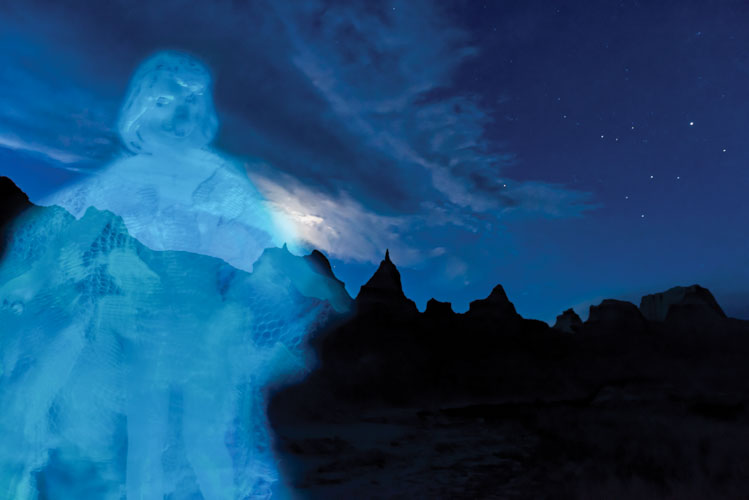 |
| Mysterious sights and sounds have long perplexed the people of the Badlands. |
The Lakota people called the rugged landscape of southwestern South Dakota mako sica, or “bad lands,” because rocky terrain, lack of water and extreme temperatures made it difficult to traverse and nearly impossible to inhabit. But it has become fertile ground for ghost stories.
A new board game called Horrified: American Monsters includes a character named the Banshee of the Badlands, which made us wonder: Is there such a creature? And what exactly is it? Our quest to track down the legend and its origins led us to other mysterious stories and encounters from this rough country.
The earliest written records of a Badlands Banshee come from Myths and Legends of Our Own Land published by Charles Skinner in 1896. Jason Offutt’s 2019 book Chasing American Monsters also includes the banshee along with other South Dakota tales like the Lake Kampeska Monster and the tiny devils of Spirit Mound.
Mateusz Wosik, a paleontologist at Misericordia University in Dallas, Pennsylvania, spent two summers as a park ranger in Badlands National Park. He used the banshee as the basis of an evening program for visitors in 2012 and 2013.
“I’m sure I scared the bejeezus out of little kids,” Wosik says. “It was a very popular program with the amphitheater full most Friday nights. There was definitely a big interest.”
Wosik approached the myths, legends and ghost stories with an explanation of how such tales get started. He believes many legends are a misinterpretation of fossils. For instance, the first discoverers of an ancient mammoth skull could mistake the hole in its center, which accommodated its trunk, as an eye socket. “So that’s where the legend of the one-eyed cyclops began,” he says. It’s also within reason, he suggests, to discover fossil remains of a real dinosaur but exaggerate them into a dragon.
The Badlands contain one of the largest deposits of fossilized prehistoric mammals in the world. Dinosaurs there became extinct around 30 million to 65 million years ago, Wosik says. Around 40 million years ago, what he calls “version 2.0” of mammals began, creating animals much closer to what we know now. “Before that they were very weird,” he says.
One of the early mammals was the titanothere, or brontothere, a large animal similar to a modern rhinoceros that lived in the Badlands and contributed to the region’s legends. South Dakota’s Native American tribes have different stories about “thunder beasts.” The combination of fossil brontotheres and modern bison most likely blended into these “thunder beings.”
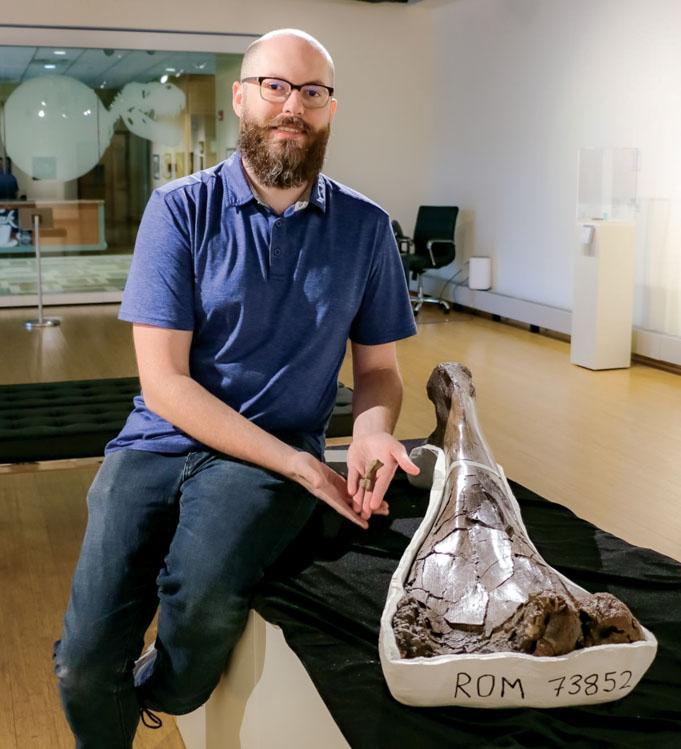 |
| Mateusz Wosik often incorporated the Badlands Banshee in talks while working as a ranger at the national park. |
As Wosik interviewed Badlands-area inhabitants for origin stories, he found that the tales vary slightly from person to person, but there was a connection between “thunder beings” and “water monsters.” A basic story tells of a father warning his son not to wander off, which of course the son ignored. A storm blew in with rain and lightning, a great battle between “thunder beings” and “water monsters.” Fossil remains of pterodactyls are the thunder beings that threw lightning bolts to the earth, which we find as fossil baculites, long pointy-shelled creatures. The water monsters would be what we now know as mosasaurs, whose fossilized skeletons have been found throughout South Dakota. They defended the earth in these great battles by throwing large boulders into the sky. The battles still create the immense noise we hear during thunderstorms. At the end of the tale the father found the boy sitting on the bones of a prehistoric water beast, one of the mosasaurs.
The folklore story of the Banshee of the Badlands came after these legends but doesn’t seem to have roots in Native American mythology. Wosik hasn’t determined if the tale is just a product of Skinner’s imagination or is based on stories he heard while in the area.
Skinner portrayed the Badlands as “hell with the fires out,” inhabited by rattlesnakes and a very unfriendly sounding place. Near a butte called “Watch Dog,” which Wosik has been unable to identify, the banshee appears to unlucky travelers. The shrieking transparent figure of a woman is common in ghost tales. “Think of the first ghost in the library at the beginning of Ghostbusters,” Wosik says. “Or the character in the video game Mortal Combat.”
Skinner described a typical encounter with the Badlands Banshee. “If war parties, emigrants, cowboys, hunters, any who for good or ill are going through this country, pass the haunted butte at night, the rocks are lighted with phosphor flashes and the banshee sweeps upon them,” he wrote. “As if wishing to speak, or as if waiting a question that has occurred to none to ask, she stands beside them in an attitude of appeal, but if asked what she wants she flings her arms aloft and with a shriek that echoes through the blasted gulches for a mile she disappears and an instant later is seen wringing her hands on her hilltop.”
“It’s like she’s wanting something, but not knowing what she wants,” Wosik explains. “It feels like a haunting, but she’s only wanting to communicate.”
Adding to the creepiness, the banshee sometimes has a companion skeleton who seeks out music. Attracted to the melodies around cowboy campfires and settlers’ cabins, the skeleton seizes any violin left in his reach and plays throughout the night. His music at times leads people into “rocky pitfalls” and eventually steals the listener’s soul.
Wosik’s interviews with Native American people from the area concluded that the skeleton must be the banshee’s loved one. “The banshee and the skeleton seem to be stuck in curses where they can’t communicate,” he says. “Maybe he’s trying to steal a soul to give her.”
Wosik enjoys incorporating established fossil knowledge into folklore. “I suspect there is a basis in the banshee tale from something like the bison and titanothere connection to ‘thunder beings.’ With the banshee there is no fossil evidence, but if we apply the other stories, it makes sense. Most of these legends are based on something real, quite often fossils misinterpreted.”
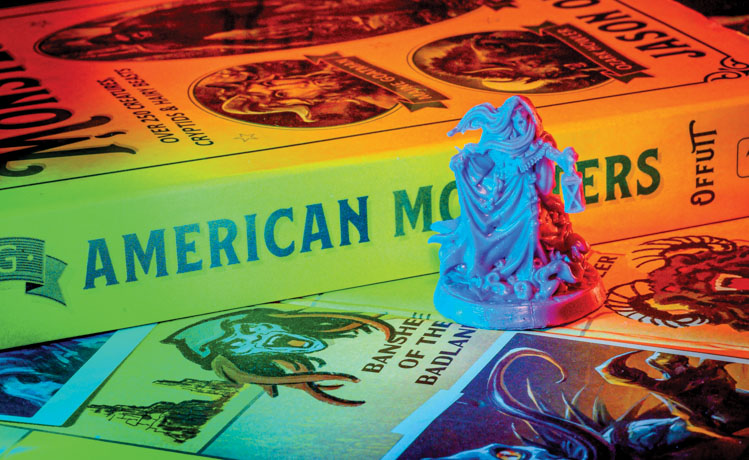 |
| The Badlands Banshee has appeared in books and games. |
How did an obscure legend turn up in a board game? Mike Mulvihill of Seattle, Washington, is responsible for the design and development of Horrified: American Monsters. “We knew that we wanted to highlight the monsters of the entire country,” Mulvihill says. “For source material we chose the book Chasing American Monsters by Jason Offutt. In looking at our map we felt we needed something in the Great Plains. When we read about the banshee, its concept was so intriguing from both an image and gameplay aspect. As we discovered more about the banshee’s background, we found out about the skeleton that accompanies her. This image of a violin-playing skeleton and the banshee is what really sold us on including the character in the game.”
A children’s version of the Badlands Banshee story is featured at a podcast called “The Cryptid Catalog.”
Badlands rancher Joe Amiotte hasn’t seen the banshee, but he has plenty of unusual stories. “About 25 years ago me and my wife and my cousin were camping by the creek roughly 15 miles south of Interior,” he recalls. “We were sitting around the campfire having a few beers and we decided to make ‘bigfoot’ noises, or at least what we thought sounded like that. We did that for about half an hour and then quit. Not too much later we heard something that wasn’t a mountain lion, not a wolf. It was growling and branches were breaking. Well, it had taken us around 20 minutes or so to set up camp, but it took us exactly five seconds to break camp and get out of there. It was a growl, a deep bark that I’d never heard before. I’ve heard mountain lions scream, I’ve heard wolves howl, it wasn’t that.”
They returned the following day to retrieve camping equipment and saw no signs of anything.
“We’ve had a neighbor who saw something in a human form from the waist up standing about 500 yards from his porch,” Amiotte says. “By the time he drove up it was a mile away, so he didn’t go after it any farther. That was in the middle of the day.”
Aaron Kaye, who serves as Chief of Interpretation for the Badlands National Park, says the area has moods. “If you walk around in the Badlands at night, you’re going to see and hear things. I’ve heard blood-curdling screams. I’m sure they were big cats, but ….”
He’s heard stories of the “Badlands yeti.” A local rancher who is now deceased reported multiple sightings of a brown, bear-like creature and finding hair from it. “He was quite convincing,” Kaye says. “For me it was just a campfire story to tell kids. And the story may change a little every time I tell it.”
Kaye also says maintenance employees at the Badlands National Park visitor center once encountered a ghostly woman in a white dress in the building after hours. She hasn’t materialized since a remodel of the center a few years ago.
There appear to be no recent banshee sightings, but other ghosts do seem to inhabit the Badlands. “Every now and then when it’s really clear out by this old homestead place you can hear kids like they are playing in the creek nearby,” Amiotte says. “It’s never scared a horse, but we can never find anything when we ride over there. Sometime in the 1930s or ’40s there was a cholera epidemic. They lost some kids, and they were buried there, so we are pretty sure it is those kids’ spirits. They are friendly though, never doing anything to scare anyone.”
They leave that for the banshee, or the yeti, or any of the other mysterious creatures whose legends live in the Badlands.
Editor’s Note: This story is revised from the September/October 2023 issue of South Dakota Magazine. To order a copy or to subscribe, call (800) 456-5117.


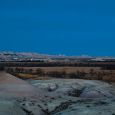
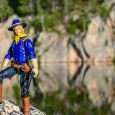
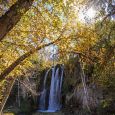

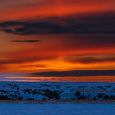
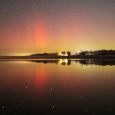


Comments